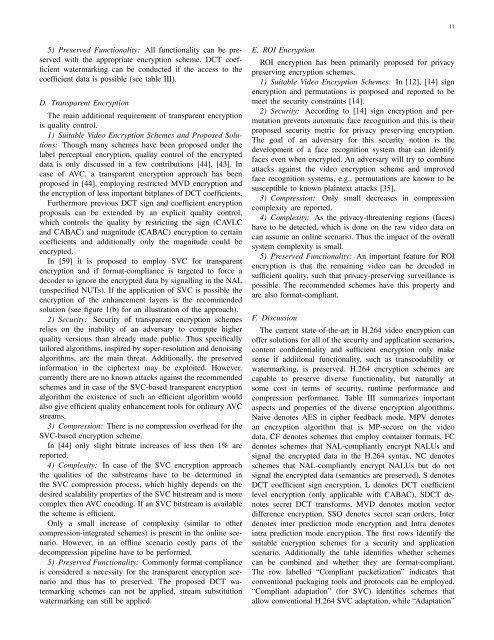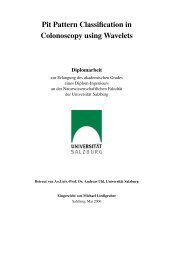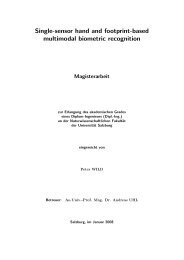A Survey of H.264 AVC/SVC Encryption
A Survey of H.264 AVC/SVC Encryption
A Survey of H.264 AVC/SVC Encryption
You also want an ePaper? Increase the reach of your titles
YUMPU automatically turns print PDFs into web optimized ePapers that Google loves.
115) Preserved Functionality: All functionality can be preservedwith the appropriate encryption scheme. DCT coefficientwatermarking can be conducted if the access to thecoefficient data is possible (see table III).D. Transparent <strong>Encryption</strong>The main additional requirement <strong>of</strong> transparent encryptionis quality control.1) Suitable Video <strong>Encryption</strong> Schemes and Proposed Solutions:Though many schemes have been proposed under thelabel perceptual encryption, quality control <strong>of</strong> the encrypteddata is only discussed in a few contributions [44], [43]. Incase <strong>of</strong> <strong>AVC</strong>, a transparent encryption approach has beenproposed in [44], employing restricted MVD encryption andthe encryption <strong>of</strong> less important bitplanes <strong>of</strong> DCT coefficients.Furthermore previous DCT sign and coefficient encryptionproposals can be extended by an explicit quality control,which controls the quality by restricting the sign (CAVLCand CABAC) and magnitude (CABAC) encryption to certaincoefficients and additionally only the magnitude could beencrypted.In [59] it is proposed to employ <strong>SVC</strong> for transparentencryption and if format-compliance is targeted to force adecoder to ignore the encrypted data by signalling in the NAL(unspecified NUTs). If the application <strong>of</strong> <strong>SVC</strong> is possible theencryption <strong>of</strong> the enhancement layers is the recommendedsolution (see figure 1(b) for an illustration <strong>of</strong> the approach).2) Security: Security <strong>of</strong> transparent encryption schemesrelies on the inability <strong>of</strong> an adversary to compute higherquality versions than already made public. Thus specificallytailored algorithms, inspired by super-resolution and denoisingalgorithms, are the main threat. Additionally, the preservedinformation in the ciphertext may be exploited. However,currently there are no known attacks against the recommendedschemes and in case <strong>of</strong> the <strong>SVC</strong>-based transparent encryptionalgorithm the existence <strong>of</strong> such an efficient algorithm wouldalso give efficient quality enhancement tools for ordinary <strong>AVC</strong>streams.3) Compression: There is no compression overhead for the<strong>SVC</strong>-based encryption scheme.In [44] only slight bitrate increases <strong>of</strong> less then 1% arereported.4) Complexity: In case <strong>of</strong> the <strong>SVC</strong> encryption approachthe qualities <strong>of</strong> the substreams have to be determined inthe <strong>SVC</strong> compression process, which highly depends on thedesired scalability properties <strong>of</strong> the <strong>SVC</strong> bitstream and is morecomplex then <strong>AVC</strong> encoding. If an <strong>SVC</strong> bitstream is availablethe scheme is efficient.Only a small increase <strong>of</strong> complexity (similar to othercompression-integrated schemes) is present in the online scenario.However, in an <strong>of</strong>fline scenario costly parts <strong>of</strong> thedecompression pipeline have to be performed.5) Preserved Functionality: Commonly format-complianceis considered a necessity for the transparent encryption scenarioand thus has to preserved. The proposed DCT watermarkingschemes can not be applied, stream substitutionwatermarking can still be applied.E. ROI <strong>Encryption</strong>ROI encryption has been primarily proposed for privacypreserving encryption schemes.1) Suitable Video <strong>Encryption</strong> Schemes: In [12], [14] signencryption and permutations is proposed and reported to bemeet the security constraints [14].2) Security: According to [14] sign encryption and permutationprevents automatic face recognition and this is theirproposed security metric for privacy preserving encryption.The goal <strong>of</strong> an adversary for this security notion is thedevelopment <strong>of</strong> a face recognition system that can identifyfaces even when encrypted. An adversary will try to combineattacks against the video encryption scheme and improvedface recognition systems, e.g., permutations are known to besusceptible to known plaintext attacks [35].3) Compression: Only small decreases in compressioncomplexity are reported.4) Complexity: As the privacy-threatening regions (faces)have to be detected, which is done on the raw video data oncan assume an online scenario. Thus the impact <strong>of</strong> the overallsystem complexity is small.5) Preserved Functionality: An important feature for ROIencryption is that the remaining video can be decoded insufficient quality, such that privacy-preserving surveillance ispossible. The recommended schemes have this property andare also format-compliant.F. DiscussionThe current state-<strong>of</strong>-the-art in <strong>H.264</strong> video encryption can<strong>of</strong>fer solutions for all <strong>of</strong> the security and application scenarios,content confidentiality and sufficient encryption only makesense if additional functionality, such as transcodability orwatermarking, is preserved. <strong>H.264</strong> encryption schemes arecapable to preserve diverse functionality, but naturally atsome cost in terms <strong>of</strong> security, runtime performance andcompression performance. Table III summarizes importantaspects and properties <strong>of</strong> the diverse encryption algorithms.Naive denotes AES in cipher feedback mode, MPV denotesan encryption algorithm that is MP-secure on the videodata, CF denotes schemes that employ container formats, FCdenotes schemes that NAL-compliantly encrypt NALUs andsignal the encrypted data in the <strong>H.264</strong> syntax, NC denotesschemes that NAL-compliantly encrypt NALUs but do notsignal the encrypted data (semantics are preserved), S denotesDCT coefficient sign encryption, L denotes DCT coefficientlevel encryption (only applicable with CABAC), SDCT denotessecret DCT transforms, MVD denotes motion vectordifference encryption, SSO denotes secret scan orders, Interdenotes inter prediction mode encryption and Intra denotesintra prediction mode encryption. The first rows identify thesuitable encryption schemes for a security and applicationscenario. Additionally the table identifies whether schemescan be combined and whether they are format-compliant.The row labelled “Compliant packetization” indicates thatconventional packaging tools and protocols can be employed.“Compliant adaptation” (for <strong>SVC</strong>) identifies schemes thatallow conventional <strong>H.264</strong> <strong>SVC</strong> adaptation, while “Adaptation”








